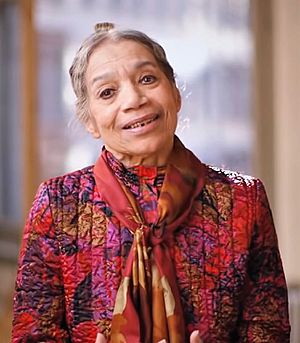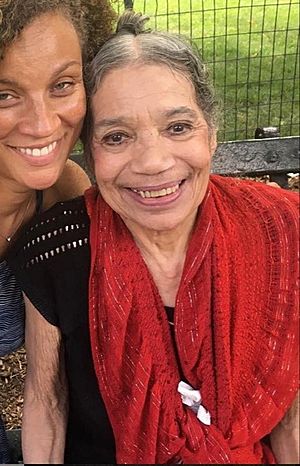Raven Wilkinson facts for kids
Quick facts for kids
Raven Wilkinson
|
|
|---|---|

Wilkinson in 2015
|
|
| Born |
Anne Raven Wilkinson
February 2, 1935 New York City, U.S.
|
| Died | December 17, 2018 (aged 83) |
| Nationality | American |
| Occupation | Ballerina |
Anne Raven Wilkinson (February 2, 1935 – December 17, 2018) was an amazing American dancer. She is known for being the first African-American woman to dance for a major classical ballet company. Raven Wilkinson broke an important barrier in 1955. She signed a contract to dance full-time with the Ballet Russe de Monte Carlo.
She became a soloist during her second year with the group. Wilkinson stayed with the company for six years. Later, she became a mentor to American Ballet Theatre principal dancer Misty Copeland.
Contents
Early Life and Ballet Dreams
Anne Raven Wilkinson was born in New York City on February 2, 1935. Her parents were Anne James Wilkinson and Dr. Frost Birnie Wilkinson. Her family lived in Harlem, a middle-class neighborhood.
Raven loved ballet from a young age. She saw the Ballet Russe de Monte Carlo perform Coppelia. Her mother, who had studied ballet, took young Raven for lessons. They were told she couldn't join until she was nine. So, she first learned the Dalcroze method. This method was all about music and rhythm.
For her ninth birthday, an uncle gave her ballet lessons. She went to the Swoboda School, which later became the Ballet Russe School. Her first teachers were famous dancers from Russia's Bolshoi Theatre.
In 1951, Sergei Denham, the director of the Ballet Russe de Monte Carlo, bought the Swoboda School. This gave Wilkinson a chance to try out for his dance group. Even though she had light skin, it was hard for her to be accepted. This was because of her race. Other ballet students told her not to even try.
In 1954, Wilkinson auditioned for the Ballet Russe. She was not accepted. She tried a second time and was rejected again. On her third try in 1955, Denham told her she was accepted. She would start with a six-week trial.
Dancing with Ballet Russe
Wilkinson became a soloist in her second year with Ballet Russe. She danced with the group for six years. She performed all over the U.S. She often danced the waltz solo in Les Sylphides. She also performed in many other ballets. These included Ballet Imperial, Giselle, and Swan Lake.
As an African American, she faced many problems while on tour. This was especially true in the segregated South. When the group stayed in "whites only" hotels, Wilkinson kept her race a secret. She later said she didn't want to put the company in danger. But she also never wanted to deny who she was.
For two years, things went well. Many dancers in the company were from other countries. So, her skin color was not a big problem. But in 1957, she was stopped from staying with the group. A hotel owner in Atlanta, Georgia, asked her if she was Black. Wilkinson refused to lie. She was sent away in a "colored" taxi to a "colored motel."
As people learned about Wilkinson's race, unfair treatment grew. It affected her personal and dance life. Denham sometimes stopped her from dancing in certain places. He sent her ahead to safer cities on the tour. Finally, one of the company's ballet teachers told her she wouldn't go further in her career. She was told to leave and start an African dance school. Wilkinson was tired of years of unfair treatment. She also felt the company was old-fashioned. So, she left in 1961.
A Break from Ballet
After leaving Ballet Russe, Wilkinson tried out for other ballet companies. These included New York City Ballet and American Ballet Theatre. But she was not accepted. She felt sad and stopped dancing for two years.
Wilkinson worked briefly in a department store. Then, she joined an Anglican convent in Fond du Lac, Wisconsin. She had always been drawn to a spiritual life. She stayed for only six months. She soon realized she had a great gift she hadn't fully used. She returned to ballet classes. Soon after, she started performing again when and where she could.
Dancing in the Netherlands
In the mid-1960s, Sylvester Campbell suggested Wilkinson try the Dutch National Ballet. He was an African-American principal dancer there. She spoke with them and was invited to join as a second soloist. She moved to the Netherlands in 1967. She stayed with the National Ballet for seven years.
She performed in many ballets there. These included Les Sylphides, The Firebird, and Giselle. In 1974, at age 38, Wilkinson missed her home. She retired and returned to the U.S.
New York City Opera
Wilkinson did not stay retired for long. When she came back to New York, the New York City Opera asked her to dance. She performed with them from 1974 until 1985. She continued with the opera as a character dancer and actor. She stayed until 2011 when the company closed.
She acted in the role of Malla in Stephen Sondheim's A Little Night Music. She also played Bloody Mary's assistant in a Broadway show. This was a new version of South Pacific in 1987.
Later Years and Legacy
Misty Copeland is the first African American to become a principal dancer at the American Ballet Theatre. She has called Wilkinson her mentor. Copeland's children's book, "The Firebird," was inspired by her friendship with Wilkinson. The story is about a young dancer who finds confidence with Copeland's help.
Wilkinson gave the 2014 Dance Magazine Award to Copeland. In June 2015, Wilkinson received the 2015 Dance/USA Trustee Award. Misty Copeland presented this award to her.
Wilkinson's life story is in Black Ballerina, a full-length movie. The film tells the stories of three Black ballerinas from the past. These are Wilkinson, Delores Brown, and Joan Myers Brown. It compares their experiences with those of three young Black dancers today.
Raven Wilkinson passed away on December 17, 2018. She was 83 years old.
See also
- Discrimination in dance


